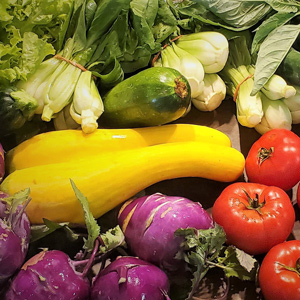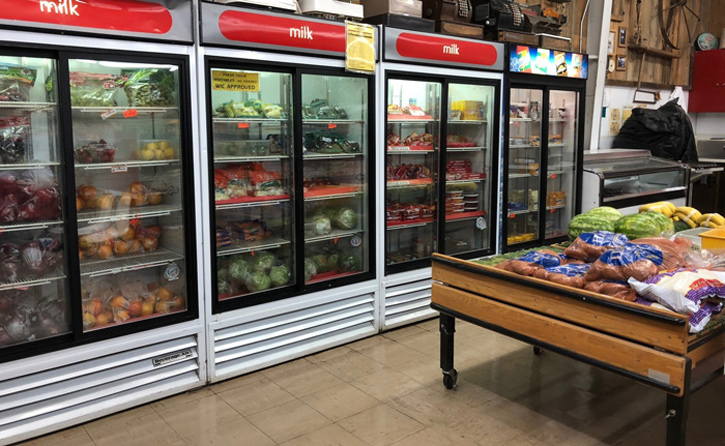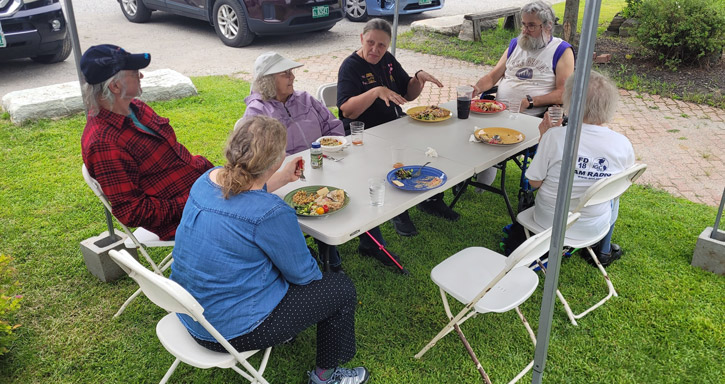Jan 24, 2024
Produce Prescription Programs Offer 'A Holistic Approach' to Addressing Rural Food Insecurity and Diet-Related Disease

In many ways, the Stop N Shop in Leland, Mississippi, is no different from thousands of other small-town grocery stores across America. Walk a quick lap around the perimeter and you'll pass by a modest selection of produce, meats, dairy products, and frozen foods. Wander down an aisle and you'll likely encounter a few neighbors small-talking, surrounded by shelf-stable processed foods with ingredient lists that seem to have been written in some complicated alien language. At the register, however, a small group of local shoppers enjoys an uncommon perk: their fresh fruits and vegetables are free.
Through a program facilitated by Delta Health Alliance, a nonprofit healthcare and social service organization, over 100 patients of Leland Medical Clinic receive a monthly $80 credit reserved for the purchase of fresh produce at the Leland Stop N Shop. The program, Delta Produce RX, is reserved for low-income individuals who suffer from diet-related chronic health conditions. Participants also attend cooking classes, meet with a nutritionist, and receive a membership to the local wellness center.
Since launching in 2020, the program has "kind of exploded," said Shelby Ballinger, Delta Produce RX program manager and a nutritionist at Leland Medical Clinic. "Word of mouth has gotten around our community, so I get a lot of calls from patients and community members who are interested in the program."

The idea is catching on nationally as well. According to a 2021 report commissioned by the nonprofit Wholesome Wave, 108 new "produce prescription" programs launched in the U.S. between 2010 and 2020. Meanwhile, new research from Tufts University supports the model's effectiveness at improving food security and various health metrics associated with diet-related disease. According to another recent Tufts University study, widespread implementation could facilitate long-term healthcare cost savings of $39.6 billion over 25 years.
But the Wholesome Wave report also noted an "unequal distribution of programs," with the model experiencing "strong growth on the coasts and within Midwestern urban cities." Produce prescription programs are still uncommon in rural areas like the Mississippi Delta, where rates of food insecurity and diet-related disease are the highest. Advocates and rural health professionals across the country are working to change that — and finding creative solutions to rural-related barriers along the way.
I think that with increased funding opportunities, it would be nice if this becomes sort of institutionally mainstreamed.
"I'm really optimistic," said Dr. Sonya Shin, Associate Professor at Harvard Medical School, who has researched the implementation and effectiveness of rural produce prescription programs. "I think that with increased funding opportunities, it would be nice if this becomes sort of institutionally mainstreamed."
Ballinger is hopeful too, having witnessed the program's impact on her patients' health metrics. "About a quarter of our participants have lowered their A1C by almost 1%, a quarter have also lowered blood pressure by almost 25 points, and almost a quarter have improved their cholesterol by 30 points — so we're definitely moving the needle," she said.
"A lot of times I'll have patients come in and their end goal is to stop taking medications," Ballinger added. "They hate taking several pills a day. Sometimes their medications make them feel bad, they have side effects. So I just feel like this is a holistic approach."
An 'Entry Point' to a Stronger Local Food System

Though food has been used throughout human history to treat various medical conditions, the origins of the modern American produce prescription model have been traced to the small town of Mound Bayou in the Mississippi Delta, just 35 miles north of Leland. In the late 1960s, Dr. H. Jack Gieger began writing food prescriptions, redeemable at local grocery stores, for food-insecure families with children. "They would take the food order to the grocery store, which would bill the community health center, and we'd pay for it from the pharmacy budget," Gieger later recalled. When questioned about the validity of this use of the pharmacy budget, he replied, "The last time I looked at my textbooks, the most specific therapy for malnutrition was food."
Today, the National Produce Prescription Collaborative defines the model as "a medical treatment or preventative service for eligible patients due to diet-related health risks or conditions, food insecurity, or other documented challenges in access to nutritious foods," which "enable[s] patients to access healthy produce with no added fats, sugars, or salt, at low or no cost to the patient." Programs vary widely in duration and design and often also include supplemental offerings such as cooking classes and nutritional counseling.
Federal support for the model has grown and evolved over the decades, from the 1992 launch of the WIC Farmers Market Nutrition Program to the establishment of the Gus Schumaker Nutrition Incentive Program (GusNIP) in 2018. The model gained further momentum in 2022, when expanded support for produce prescription programs and other "food is medicine" interventions was included in the White House National Strategy on Hunger, Nutrition, and Health.

The recent surge of new programs and funding opportunities comes amid a widespread transition to value-based payment models and an accompanying interest among many providers in addressing the environmental factors that contribute to health outcomes and disparities. "As clinicians, we know very well that the social determinants of health eclipse any medication or medical intervention we can think of," said Shin — who, in addition to her role at Harvard, is also a practicing physician in Gallup, New Mexico, near the border of the Navajo Nation.
Shin is one of the founders of the COPE Navajo Fruit & Vegetable Prescription Program (COPE Navajo FVRx), which launched in 2014 as the first rural, tribal-based program of its kind. Prior to the launch of COPE Navajo FVRx, Shin had seen firsthand how existing treatment protocols were failing her patients with diet-related chronic conditions, most of whom were also low-income and food-insecure. Often, patients were experiencing serious complications by the time they began receiving treatment for conditions such as diabetes. Shin wondered, "What can we do to actually prevent diabetes instead of trying to manage it?"
What can we do to actually prevent diabetes instead of trying to manage it?
From conversations with patients about nutrition, she quickly learned that "they already know what is healthy, they just can't get ahold of it." For many low-income, food-insecure individuals, the barriers to better nutrition are manifold — from the higher cost of healthy foods to limited fresh produce availability in some rural communities and low-income neighborhoods. In many cases, it makes more immediate economic sense for food-insecure individuals to purchase low-cost, calorie-dense, highly processed foods with the limited funds they have available — choices that may exacerbate existing health issues or lead to an array of problems down the road.
Shin and her colleagues at Community Outreach and Patient Empowerment (COPE), a 501(c)3 based in Gallup, designed COPE Navajo FVRx with these complex variables in mind. In addition to implementing a produce prescription program for pregnant mothers and families with young children, they launched a partner program, Healthy Navajo Stores Initiative (HNSI), to promote produce availability at local supermarkets, convenience stores, and other small shops. HNSI has assisted participating stores with shelf and cooler acquisition, produce marketing initiatives, and training on proper produce handling and storage. Participating stores are also invited to become a site where COPE Navajo FVRx vouchers may be redeemed.
An assessment of COPE Navajo FVRx's impact, co-authored by Shin, reported that "food insecurity significantly decreased from 82% to 65%" among participating households. Additionally, "a subgroup analysis of children who were initially overweight or obese found that more than a third of children returned to a healthy BMI percentile at the end of the 6-mo program, and their average BMI percentile declined from 95.6 to 73.1." A separate assessment of the HNSI program found that local shoppers — not just those enrolled in COPE Navajo FVRx — "experienced 150% higher odds of purchasing produce if they shopped in participating stores, compared with nonparticipating stores."
These results suggest that some produce prescription programs may have wide-ranging impacts beyond those experienced by enrolled participants, such as economic benefits to rural grocery stores and increased fresh produce availability for entire communities. "For rural communities, I think that a produce prescription program could be — I use the analogy of a climbing wall, where you just need one grip to start climbing the wall," said Shin. "A produce prescription program could be that entry point into building stronger food systems."
A Prescription from the 'Farmacy'

Some program models increase produce consumption and support local food systems without sending participants to the grocery store. For example, The Farmacy Project, serving Rutland County, Vermont, partners with local farms to distribute bags filled with fresh produce to around 250 participants every week throughout the summer growing season. The program creates "a link between farm viability and public health while weaving together educational and cultural experiences," wrote Project Director Emma Hileman in a journal article. According to Hileman, the program has invested over $325,000 into the local agricultural economy and served 3,647 residents since launching in 2015.
The Farmacy Project is run by the nonprofit Vermont Farmers Food Center, which partners with various local agencies for participant referrals — from the local hospital and clinics to a chiropractic office, behavioral health organization, and the county WIC program. There are no set income or medical requirements for eligibility. "We tell providers that if somebody could benefit from having more vegetables in their diet, then those are good people to sign up for the program," said Hileman, adding that around 65% of participants are considered low-income.
For 15 weeks beginning in late June, participants pick up bags from one of eight sites scattered throughout the county, with delivery available for individuals who face mobility or transportation barriers. "A great group of volunteers" assists with assembling the bags and making deliveries every week, said Hileman. The bags typically include 10 pounds of fresh produce, aggregated from around a dozen small farms in the region. At the beginning of each season, Hileman works with participating farms to determine up-front payments for seed purchasing and negotiate fair prices for crops.
The seasonal nature of the farm-share model in the northeast does have its drawbacks, said Hileman. "We've seen some people do really great during the summer, then our program ends and they backtrack," she said. However, voucher-based programs are often also time-limited, lasting between 6 months and a year — and most do not allow for the possibility of re-enrollment, as The Farmacy Project does. Another challenge is the significant amount of work required to coordinate multiple partners, including the Vermont Farmers Food Center, volunteers, referring agencies, funders, and farmers. But for Hileman and others, the benefits of their unique model far outweigh any difficulties.
"I'm a huge proponent of the CSA [community supported agriculture] model for various reasons," said Hileman. While voucher-based programs allow for more consumer choice, the CSA model encourages participants "to try something new, to learn about a new vegetable." Each week's bag comes with a recipe card that includes adaptations for participants with limited supplies or cooking skills. Additionally, the program has offered classes on cooking, canning, and preserving, though educational offerings vary from year to year.

But Hileman's favorite aspect of the farm-share model is something of an unexpected side effect: an increased sense of connection among participants. "It's just much more community building," said Hileman. "We host potlucks. We have the farmers interact with the people who are eating their food. Even the aspect of people just picking up their shares — they have somebody they're interacting with. They have a social connection. Honestly, sometimes it's way more about that for our participants than it is about the food."
They have a social connection. Honestly, sometimes it's way more about that for our participants than it is about the food.
Hileman's article includes the story of a man named Frank, who met his current partner as a result of their mutual participation in the program. In a testimonial, Frank highlighted the social benefits of The Farmacy Project: "My feeling is that's what programs like this is all about, helping each other out, you know it's being sociable, it's having somebody during the week to say hey, how ya doin'? And you know it makes a difference in your life."
Pathways to Sustainability
Despite promising results and positive feedback from participants, the future of Delta Produce RX in Leland is uncertain. Delta Health Alliance is nearing the ending of the grant period for the U.S. Department of Agriculture and GusNIP funding that supported the program's creation. Currently, Ballinger and her colleagues are in the process of planning a community garden on the grounds of Leland Medical Clinic. If no additional funding is secured for the program, the garden may be able to offer a modest amount of free produce to former participants — though not anything like the quantity they received while enrolled in the program.
"Sustainable funding is still tricky" for many produce prescription programs, according to Melissa Akers, Manager of the Food Policy, Health, and Hunger Research Program at the University of California San Francisco School of Medicine. Akers is a co-author of the Rural Produce Prescription Toolkit, which offers a wealth of information for organizations interested in starting and sustaining programs in rural areas. As part of the research process for the toolkit, Akers interviewed over a dozen "key informants" working with rural produce prescription programs across the country. Funding came up frequently as the most significant barrier to program growth.
While most existing programs are grant-funded, there is "a lot of collective energy and momentum around having produce prescription programs become billable under Medicaid," said Akers. For instance, section 1115 demonstration waivers permit organizations in a growing number of states to receive reimbursement from CMS for various "food is medicine" interventions, including produce prescriptions. Akers expects more funding pathways to emerge in the coming years.
"I think that having it become adopted by health plans and billable or reimbursable will be wonderful for reaching a lot of people," said Akers. However, she also expressed concerns about the potential loss of the "community aspects" of the model as it is adopted by larger entities.

In Rutland, the long-running Farmacy Project has been supported over the years by a "hodgepodge" of grants from multiple organizations, said Hileman. Funding sources have ranged from a $500 micro-grant from a local bank to more substantial, ongoing funding from organizations like United Way. In the future, Hileman hopes to transition to a "fee-for-service model," in which partners seek out their own funding to pay for their patients' participation in the program.
One partner, the Rutland County Free Clinic, has readily embraced this new funding approach. For the past two years, Executive Director Tia Poalino has successfully applied for grants to cover the costs of the patients they refer to the program, numbering around 30. Poalino said she would "highly recommend" partnering with or offering a produce prescription program to other small, rural clinics.
"The most common thing I hear from our patients is, 'I would never have access to food like this if it weren't for this program — and neither would my children — because we simply cannot afford to go and buy fresh produce like this at the farmers market or in the grocery store,'" said Poalino.
The second most common feedback she hears is that patients are "feeling better" and inspired to make additional improvements to their health. "When they see what a difference just eating healthier makes for them, some think, 'Well, gee, maybe I could cut back on smoking, cut back on drinking, try to get more sleep,'" said Poalino. "I go back to this word: they feel empowered."
